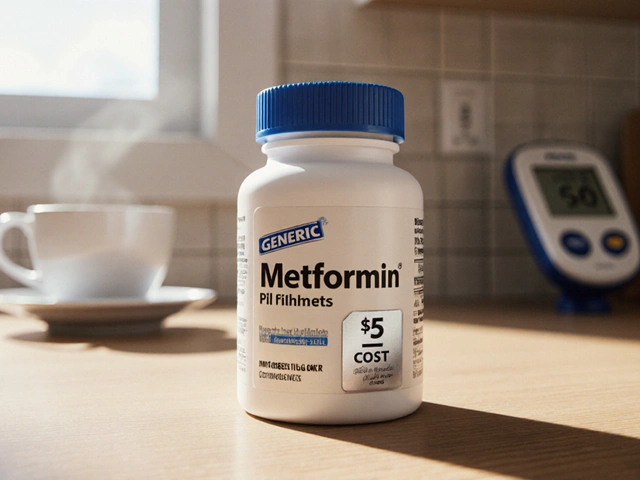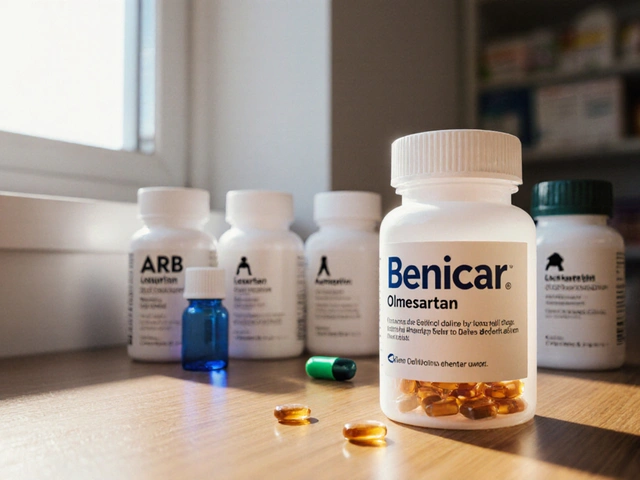HIV Protease Inhibitor Comparison Tool
Select your current or preferred HIV protease inhibitor to compare key features:
| Drug | Dosing Frequency | Side Effects | Cost Considerations | Efficacy |
|---|---|---|---|---|
| Indinavir | 3-4 times daily | Kidney stones, gastrointestinal issues | Moderate | High |
| Atazanavir | Once daily | Minimal GI, mild bilirubin elevation | Moderate-high | High |
| Darunavir | Once daily | Minor GI issues, rare rash | High | Very High |
| Lopinavir/Ritonavir | Twice daily | High lipid levels, GI upset | Low | High |
| Fosamprenavir | Once daily | Fewer GI issues than indinavir | Moderate | High |
Did you know the protease inhibitor that hit the market in 1996 is still one of the leading culprits for kidney stones in people living with HIV? Indinavir is a protease inhibitor that blocks the HIV‑1 protease enzyme, halting the virus from maturing into infectious particles. While it helped millions achieve viral suppression, newer drugs promise fewer side effects and simpler dosing. If you’re weighing Indinavir alternatives, you need more than a list - you need a clear picture of how each option stacks up on efficacy, safety, cost, and convenience.
Key Takeaways
- Indinavir requires strict dosing on an empty stomach and can cause kidney stones.
- Atazanavir and Darunavir are once‑daily options with better metabolic profiles.
- Lopinavir/ritonavir is affordable but needs twice‑daily dosing and has high lipid‑raising potential.
- Fosamprenavir offers a middle ground: once‑daily dosing with fewer gastrointestinal issues.
- Switching drugs involves checking viral load, CD4 count, drug interactions, and insurance coverage.
How Indinavir Works - The Science in Simple Terms
Indinavir belongs to the class of protease inhibitors. It binds to the active site of the HIV‑1 protease enzyme, preventing the cleavage of gag‑pol polyproteins. Without this step, the virus cannot assemble mature, infectious particles, leading to a drop in viral load. The drug reaches peak plasma levels about one hour after a 800mg dose, but its short half‑life (≈1.8hours) forces patients to take it three or four times a day.
What to Compare When Evaluating Protease Inhibitors
Not all protease inhibitors are created equal. Below are the core criteria that matter most to patients and clinicians:
- Efficacy: Ability to maintain viral suppression (RNA<50copies/mL) in treatment‑naïve and experienced patients.
- Dosing convenience: Once‑daily vs. multiple daily doses, and food requirements.
- Side‑effect profile: Metabolic disturbances, renal toxicity, GI issues, and cardiac effects.
- Drug‑drug interactions: Particularly with statins, anti‑epileptics, and hormonal contraceptives.
- Cost and insurance coverage: Average wholesale price (AWP) and patient assistance programs.
- Resistance barrier: How easily HIV can develop mutations that diminish drug activity.

Side‑by‑Side Comparison of Popular Options
| Drug | Class | Dosing Frequency | Common Side Effects | Food Restrictions | Avg. US Cost (per month) |
Notable Interactions |
|---|---|---|---|---|---|---|
| Indinavir | Protease inhibitor | 800mg 3-4×/day | Kidney stones, hyperbilirubinemia, lipodystrophy | Take on an empty stomach (30min before/2hr after meals) | ≈$1,200 | Rifampin, azoles, norethindrone |
| Atazanavir | Protease inhibitor | 300mg once daily (with ritonavir boost) or 400mg qd unboosted | Jaundice, mild hyperglycemia, mild renal impact | Take with food to improve absorption | ≈$1,350 | Antacids, didanosine, cobicistat |
| Darunavir | Protease inhibitor | 800mg once daily (with ritonavir) or 600mg bid (with ritonavir) | Diarrhea, nausea, rash, higher lipid levels | Can be taken with or without food | ≈$1,500 | St.John’s wort, carbamazepine, certain statins |
| Lopinavir/ritonavir | Protease inhibitor (fixed‑dose combo) | 400/100mg twice daily | Elevated triglycerides, GI upset, taste changes | Take with food (high‑fat meals improve absorption) | ≈$800 | Warfarin, antihypertensives, methadone |
| Fosamprenavir | Protease inhibitor (pro‑drug) | 700mg once daily (with ritonavir) or 700mg bid (with ritonavir) | Headache, nausea, mild hyperbilirubinemia | Take with food | ≈$1,100 | Azoles, macrolide antibiotics, steroids |
Deep Dive into Each Alternative
Atazanavir - The “Gentle” Protease Inhibitor
Atazanavir’s main selling point is its once‑daily dosing and relatively mild metabolic impact. It’s often the go‑to for patients who develop dyslipidemia on other PIs. However, the drug can cause indirect bilirubin elevation, leading to visible jaundice in up to 9% of users. For people with pre‑existing liver disease, this may be a deal‑breaker.
Darunavir - The High‑Barrier Option
Darunavir is praised for its high genetic barrier to resistance, making it a solid choice for treatment‑experienced patients. When boosted with ritonavir, it achieves plasma levels that suppress even multi‑drug‑resistant strains. The downside? The boost adds extra pill burden and can increase cholesterol and triglycerides.
Lopinavir/Ritonavir - The Budget‑Friendly Veteran
Lopinavir/ritonavir (Kaletra) has been around the longest and is heavily featured in WHO’s recommended first‑line regimens for low‑resource settings. Its twice‑daily schedule and strong effect on lipid profiles are the main drawbacks. Still, for patients with limited insurance coverage, its lower price makes it attractive.
Fosamprenavir - The Pro‑Drug with Flexibility
Fosamprenavir converts to amprenavir after ingestion, offering better bioavailability. It can be taken once daily when boosted, and it generally causes fewer GI complaints than indinavir. However, it is not as widely available in generic form, keeping costs moderate.
Choosing the Right Drug for You - A Practical Decision Tree
- Assess kidney health. If you have a history of nephrolithiasis, steer clear of Indinavir.
- Check lipid profile. For high LDL or triglycerides, prioritize Atazanavir or Darunavir (unboosted).
- Consider dosing convenience. Once‑daily regimens improve adherence - Atazanavir, Darunavir (boosted), and Fosamprenavir fit this need.
- Review drug‑interaction list. If you’re on statins, avoid ritonavir‑boosted combos that raise statin levels (e.g., Lopinavir/ritonavir).
- Look at insurance coverage. Generic Indinavir may be cheaper out‑of‑pocket, but formulary restrictions might favor Lopinavir/ritonavir.
Once you rank these factors, discuss the shortlist with your clinician. A small blood test (viral load + CD4 count) plus a renal panel will confirm whether switching is safe.
Practical Tips for Switching from Indinavir
- Schedule the change during a low viral load. Ideally, your last Indinavir dose should be followed by the new drug within a 12‑hour window to avoid a “drug holiday.”
- Hydrate well. Extra fluids reduce the risk of kidney stones if you stay on Indinavir during the transition period.
- Monitor labs closely. Check renal function, bilirubin, and lipids at weeks 2, 4, and 12 after the switch.
- Watch for rebound symptoms. Some patients feel a temporary rise in fatigue as the new drug reaches steady state.
- Update your medication list. Make sure pharmacy records, pillboxes, and mobile reminders reflect the new dosing schedule.

Frequently Asked Questions
How does Indinavir differ from newer protease inhibitors?
Indinavir requires multiple daily doses on an empty stomach and can cause kidney stones. Newer agents like Atazanavir and Darunavir are once‑daily, have fewer renal issues, and often need a low‑dose booster rather than strict fasting.
What are the most common side effects of Indinavir?
Patients typically report kidney stones, mild hyperbilirubinemia (yellowing of the eyes), lipodystrophy, and occasional gastrointestinal upset.
Which alternative is best for someone with high cholesterol?
Atazanavir is often preferred because it has a neutral or even lowering effect on cholesterol, whereas Lopinavir/ritonavir and boosted Darunavir can raise lipid levels.
Are there generic versions of these drugs?
Indinavir became generic in 2015, making it the cheapest option on the list. Atazanavir and Darunavir now have generic forms in many countries, while Lopinavir/ritonavir is widely available as a low‑cost generic.
Can I switch directly from Indinavir to an integrase inhibitor?
Yes, but you’ll need a bridging period to avoid drug‑drug interactions. Your clinician will likely run a viral load test and may add a short course of a non‑boosted PI before starting an integrase inhibitor such as Dolutegravir.







September 29, 2025 AT 12:45
Indinavir still haunts many veterans of early HIV therapy, demanding three to four daily doses on an empty stomach and flirting with kidney stones at every turn.
Its potency is undeniable, yet the sheer inconvenience can erode even the most disciplined adherence.